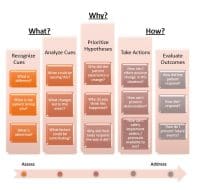The World Health Organization recognized 2020 (extended to 2021) as the Year of the Nurse, and nurses have certainly showed up! Amid the global COVID-19 pandemic, nurses are doing what we do best. We are standing tall, rolling up our sleeves, and caring for the people around us. An obvious, but often neglected question is, “Great, but who is caring for nurses?” The pandemic has amplified an existing epidemic of compassion fatigue and burnout among nurses.
Before the pandemic, our profession was being engulfed by the insidious epidemic of non-stop action that has slowly evolved into the chaotic work environment we define as nursing today. The “work until you drop” mentality, where nurses consistently skip lunches and delay bathroom breaks, has sadly become the norm. Nurses today seem to brag about this perpetual motion as a badge of honor. For nursing to continue to evolve in a healthy and sustainable manner, we must redefine success within our profession.
How do we remove the badge of honor associated with the “epidemic of non-stop” and redefine nursing in a way that meets the needs of the community, while also underscoring the vital need for nurses to also care for themselves? Highlighting the importance of nurse well-being, the American Nurses Association launched their 2018 grand challenge, Healthy Nurse, Healthy NationTM, which encourages nurses, their employers, and organizations to improve health in five key areas: quality of life, physical activity, safety, rest, and nutrition.
In an early draft of this article we received feedback that the self-care topic was “cliché and done” and that it wasn’t practical to advise people to set boundaries and engage in self-care when they work within a system that doesn’t allow for these things. Another comment was “easier said than done.” The irony of this feedback wasn’t lost on us and actually underscored the need for more attention to this topic.
Caring for ourselves doesn’t come naturally to nurses, but you can’t give from an empty cup, and rates of depression among healthcare providers are at an all-time high, with suicide attempts on the rise. What’s even scarier is that these phenomena were noted before the pandemic. A paradigm shift is necessary because this early review was correct, we do work within systems that don’t prioritize self-care. Our contention is, however, that self-care needs to be seen as a priority and necessity, not a luxury, in the work that we do. It’s going to take a grassroots movement within every facet of the nursing profession to change the status quo.
Call to action
Nursing professors, we challenge you to educate your students about the importance of self-care, and “walk the walk” by demonstrating and discussing your own forms of self-care. To truly engage nurses, we must start on day one of their nursing journey. Nursing curriculum and culture must embody the promotion of health and well-being through self-care.
Nurses enter into a caring profession and often prioritize the health, safety, and wellness of their patients’ above their own. Explicit and embedded messaging in nursing education can be the catalyst for nurses’ prioritization of their own well-being. This may take different forms ranging from a health-promotion course, to a surprise “quiz” that allows a nursing student to engage in a self-care activity. Furthermore, nursing professors may encourage intentional rest on school holidays and weekends and show compassion when students have “real life” compound their educational journey. Lastly, acknowledging that we are all human on a journey of self-care and that every action of self-care can go a long way.
Nursing managers, we challenge you to demonstrate your own commitment to self-care through your communication with your staff and your subsequent actions. For managers in acute facilities, this may mean creative staffing rotations or advocacy to leadership to ensure reasonable patient number and acuity assignments. For community-based or other outpatient facilities, this could take the form of expectation setting regarding email correspondence or review of lab values, etc. outside of scheduled shifts.
We all know that at times, emergency meetings must be called or nurses have to be asked to pitch in when a co-worker is unexpectedly out. If these are the exception rather than the norm, your staff will know that you respect them both as an employee and as a person (e.g., mom, dad, son, niece, friend). This will go a long way to creating a supportive work environment that actively demonstrates the value placed on nursing staff.
Staff nurses, we challenge you to set appropriate boundaries, stick to them, and then teach the next generation of nurses and fellow co-workers to do the same. How many times have you told yourself that a bathroom break can wait? How many times have you agreed to take another admission knowing that you are drowning with your current patient load? How many times have you precepted a new nurse or nursing student and found yourself perpetuating this behavior as the norm? In order to reverse the current non-stop epidemic, the answers to these questions have to change.
The longer we say yes to more work without acknowledging our own needs, the longer and harder it will be to dig ourselves out of the hole we are in. A clinical environment where nurses engage in self-care allows for realistic outcomes to be measured, and in doing so gives management the opportunity to recreate nursing expectations. A wise adage goes, “in order to care for patients well, one must first care for themselves.” The airline industry demonstrates this concept perfectly in their instruction to put the air mask on yourself before you help others. It’s about time nurses did the same.
Working together
This is a call to action for nurses across all settings and in all roles to do what they can where they are to acknowledge, teach, and engage in self-care. We must work together to change the trajectory of our profession to develop and sustain a nursing workforce that is sensitive to the dangers of burnout and understands the importance of prioritizing self-care.
LaTashia Kiel is a clinical assistant professor and Cara Young is an associate professor at The University of Texas at Austin School of Nursing in Austin, Texas. Amy E. Papermaster is an assistant professor at The University of Texas at Austin School of Nursing and Dell Medical School in Austin, Texas.



















1 Comment. Leave new
YES! Thank you for this call to action. As a graduate student in a Nursing Education program, I am so grateful to hear this call– and am already looking to develop and teach a course in Caring for the Self so that future nurses know how to maintain healthy boundaries, how to notice signs of empathic and moral distress (and what to do when they notice) and how to engage in self-caring activities from day one– whether they are new or experienced nurses. Our Patients deserve the best– and we provide that by doing better for ourselves.